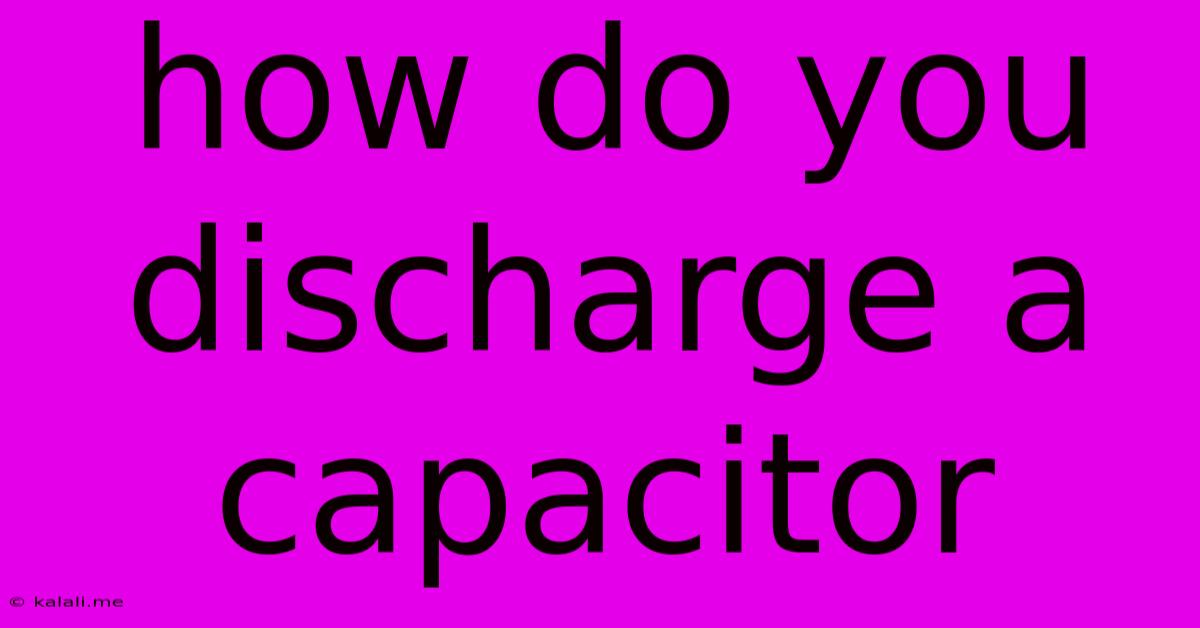How Do You Discharge A Capacitor
Kalali
May 24, 2025 · 3 min read

Table of Contents
How to Discharge a Capacitor Safely: A Comprehensive Guide
Discharging a capacitor is a crucial safety procedure for anyone working with electronics. Capacitors, even small ones, can store a significant electrical charge, posing a risk of electric shock or damage to equipment if not handled correctly. This guide provides a detailed explanation of safe capacitor discharge methods, catering to both beginners and experienced electronics enthusiasts. Understanding the potential dangers and employing the correct techniques is paramount to ensuring your safety and the longevity of your equipment.
Why Discharge a Capacitor?
Before diving into the how, let's understand the why. Discharging a capacitor is essential because:
- Safety: A charged capacitor can retain its charge for a considerable time, even after the power source is removed. This residual charge can deliver a painful and potentially dangerous shock.
- Equipment Protection: A charged capacitor can damage sensitive electronic components during maintenance or repair. The sudden surge of energy can fry transistors, integrated circuits, and other delicate parts.
- Preventing Accidental Discharge: An unexpectedly discharged capacitor might cause damage to the circuit or even lead to a fire. Controlled discharging is necessary for preventive maintenance.
Methods for Discharging a Capacitor
Several methods exist for safely discharging a capacitor, each suitable for different scenarios and capacitor sizes. Choosing the right method depends on the capacitor's voltage and capacitance.
1. Using a Discharge Resistor
This is the most common and generally safest method for most capacitors. A high-wattage resistor (typically 10-100kΩ) is connected across the capacitor's terminals. The resistor's value should be chosen to allow a safe discharge rate without excessive heat generation. The resistor dissipates the stored energy as heat. Always ensure the resistor is appropriately rated for the voltage and power dissipation involved.
- Advantages: Simple, readily available components.
- Disadvantages: Slower discharge rate than other methods.
2. Using a Discharge Tool
Specialized capacitor discharge tools are available, offering a safer and often faster discharge than using just a resistor. These tools provide a controlled path for the charge to dissipate, reducing the risk of accidental shock. Some tools incorporate safety features like insulated handles and current limiting.
- Advantages: Faster discharge, improved safety features.
- Disadvantages: Requires specialized equipment, can be more expensive.
3. Shorting the Terminals (Use with Extreme Caution!)
This method involves directly shorting the capacitor's terminals with a conductive material, like a wire. This method should only be employed as a last resort and only with low voltage capacitors. Never use this method on high-voltage capacitors. The sudden discharge can generate a significant spark, potentially causing burns or damage. Always use insulated tools to avoid direct contact.
- Advantages: Fast discharge.
- Disadvantages: Extremely dangerous, high risk of burns and equipment damage. Not recommended for inexperienced users.
Safety Precautions:
- Always assume a capacitor is charged until proven otherwise.
- Never touch the capacitor terminals directly. Always use insulated tools.
- Wear appropriate personal protective equipment (PPE), including safety glasses and insulated gloves.
- Work in a well-ventilated area, especially when discharging larger capacitors, as heat can be generated.
- Double-check your connections before discharging a capacitor to avoid accidental shorts or incorrect wiring.
- Understand the capacitor's specifications (voltage and capacitance) before attempting to discharge it.
Conclusion:
Safely discharging a capacitor is a critical skill for anyone working with electronics. By understanding the risks and employing the appropriate methods, you can significantly reduce the risk of electric shock and equipment damage. Prioritizing safety is essential, and using a discharge resistor or a specialized tool is always recommended over shorting the terminals directly. Remember, patience and caution are key when handling capacitors.
Latest Posts
Latest Posts
-
Pvc Drain Pipe Leaking At Joint
May 24, 2025
-
How To Vent Bathroom Fan Out Soffit
May 24, 2025
-
Light Green Grass Patches In Lawn
May 24, 2025
-
Disable Power Grid Watch Dogs 2
May 24, 2025
-
Why Does My Dishwasher Smell Like Sewer
May 24, 2025
Related Post
Thank you for visiting our website which covers about How Do You Discharge A Capacitor . We hope the information provided has been useful to you. Feel free to contact us if you have any questions or need further assistance. See you next time and don't miss to bookmark.